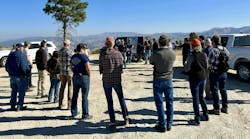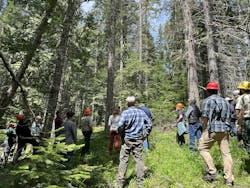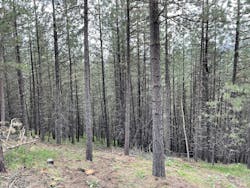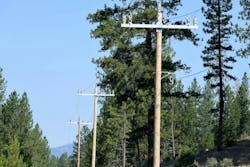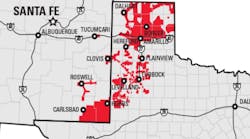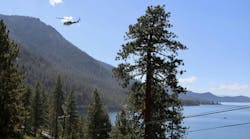Like all utilities, Idaho Power places safety and reliability at the heart of its operations. It never stops working to make the grid safer and more resilient, and to protect the communities and wildlands that make southern Idaho and eastern Oregon so special. The company’s wildfire mitigation plan includes proactive strategies to limit wildfire risk. These strategies include the installation of wildfire-mitigating equipment, situational awareness tools and capabilities that support fire-weather forecasting, and operational practices and procedures aimed at further limiting the risk of wildfire.
Utilities across the West share many approaches to wildfire mitigation. Idaho Power and an impressive group of partners are using a novel approach on top of traditional methods. Through prioritized forest restoration projects that include fuel clearing across the public-private divide, this group is working to break down a perennial brick wall that has frustrated attempts to address wildfire risk at a scale necessary for the broader good.
Partner-Driven
Idaho Power works alongside the U.S. Forest Service, Bureau of Land Management, U.S. Fish and Wildlife Service, Idaho Department of Lands, counties, fire protection organizations, and several nonprofits to plan for and implement large projects aimed at protecting local communities and the grid from wildfire. The effort spans 2 million acres (809,371 hectares) in southern Idaho and incorporates partner-driven strategies for vegetation management. For example, trees that may be a fuel source for wildfire are being thinned or removed next to powerlines at a pace and scale that would have been hard to imagine just a few years ago.
“It really is impressive to see what we can all do when we put our heads together,” Idaho Power T&D Engineering and Reliability Senior Manager Jon Axtman said. “It just goes to show that agencies across the West, whether they’re at the federal, state or local level, care about getting wildfire mitigation right.”
A Strategic Initiative
Protecting the grid while safely powering customers’ homes, farms and businesses is growing more complicated as wildfires become more common in the West. For the last 100 years, wildfire suppression has been a leading strategy across western forests in the U.S., resulting in fuel accumulation and forest conditions that have driven up wildfire risk.
Meanwhile, the population has soared in Idaho Power’s service area. Boise, Idaho, is often listed as one of the 10 fastest growing cities in the nation. More and more of its residents are seeking out the natural places that draw people to the state. For example, some customers build homes in the sagebrush, forests and other wildfire-prone areas, further complicating the task of reducing wildfire risk while continuing to provide reliable energy.
In Ada County, where Boise is located, the intermingling of people, buildings and vegetated land known as the wildland-urban interface (WUI) more than doubled between 1990 and 2020. A patchwork of private and state ownership interspersed with areas managed by the U.S. Forest Service or Bureau of Land Management make widespread fuel reduction difficult to implement across large areas.
That is where the teamwork between Idaho Power and land management agencies, local government and private groups comes in. In 2021, the U.S. Forest Service announced a 10-year initiative, Confronting the Wildfire Crisis: A Strategy for Protecting Communities and Improving Resilience in America’s Forests. The strategy aims to dramatically increase the scale and pace of forest health treatments over the next decade by allowing the Forest Service to treat up to an additional 20 million acres (8 million hectares) on National Forest System lands and up to an additional 30 million acres (1.2 million hectares) of other federal, state, tribal and private lands.
A cornerstone of the initiative is encouraging partnerships that strategically focus on reducing wildfire fuels and use science to guide prioritization. The selection of 10 initial landscapes, including the Boise National Forest, for focused investment from Bipartisan Infrastructure Law funding accompanied the initiative’s introduction.
Working Together
As part of its wildfire mitigation efforts, Idaho Power already has a robust vegetation management program that focuses on clearing vegetation around its overhead power lines to create a safety envelope, or buffer, between utility facilities and vegetation. This work is important for reducing fire risk, particularly in forested areas. However, utilities often do not have access or must seek permission to manage vegetation on lands and rights-of-way they do not control.
The Wildfire Crisis strategic initiative presented a new opportunity to think about wildfire risk while working with partners to influence planning and implementation.
“When it comes to collaboration, there’s no substitute for a comprehensive plan that touches a need acknowledged by everyone,” Axtman said. “Once we all recognized that we are working to achieve the same thing, we just needed to develop a strategy to move the ball forward together and then get to work. That’s exactly what we’re doing.”
Idaho Power’s partnership with federal, state and local land management agencies as well as the nonprofit community is already reducing fuel buildup in areas the utility has identified as at high risk for wildfires. In 2023, approximately 48,000 acres (19,425 hectares) of high fuel-loaded forests were thinned, including 800 acres (324 hectares) near Idaho Power lines and other equipment in locations identified as high-risk fire zones in the utility’s wildfire mitigation plan.
Fundamental to these accomplishments is the ability to work across ownership boundaries, outside of the utility rights-of-way and with already mobilized contractors.
“There’s a ton more work to do, but we’re moving in the right direction,” Axtman said. “Every acre that is cleaned up makes our customers, employees, communities, and equipment safer and more prosperous. That’s a goal worth working together for.”
The Southern Idaho All Lands Partnership group is now working to develop the portfolio of projects that will be implemented over the next five years.
While wildfire risk reduction through fuel clearing remains the primary goal of this initiative, there are ancillary benefits. Local economies are seeing increased activity through work opportunities for smaller-scale forest operators. These opportunities help communities in the project area and surrounding tribal nations through firewood banks and other programs. They also help to protect the health of major drinking water source watersheds vital to Idaho, including the Boise, Payette and Weiser subbasins.
Partnership Approach
The partnership approach has provided a conduit for identifying and securing additional funding that might not be available to a single group. This has amplified the U.S. Forest Service’s investment in the Wildfire Crisis strategic initiative. Over the next 10 years, partners in this initiative expect additional investments of more than US$180 million to reduce wildfire risk in southern Idaho, showcasing a holistic, community-built solution for addressing wildfire risk. This risk reduction could not be realized without the public and private network working together. Idaho Power has high hopes for this collaborative model and believes it could be replicated and scaled in other Western states.
Dani Southard ([email protected]) is the wildfire mitigation program manager for Idaho Power. She is a participant in the Southern Idaho All Lands Partnership group on the Boise and Payette National Forests.
